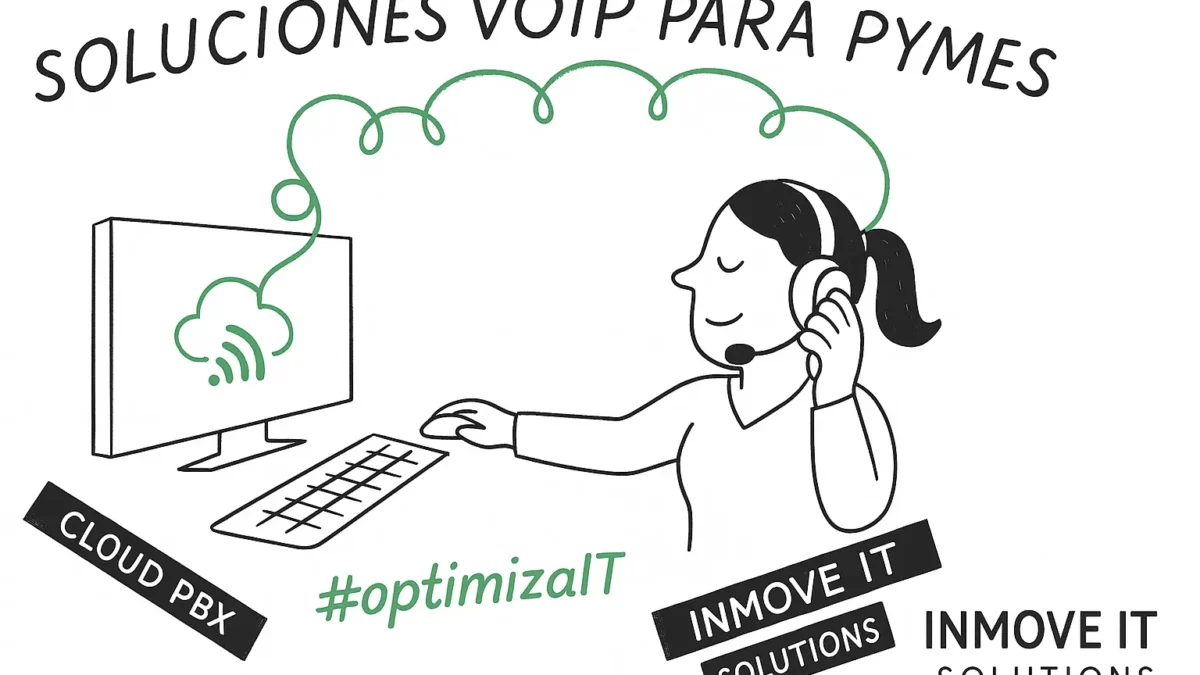This article presents, from a technical-consultive perspective, how an SME in the logistics sector based in Barcelona migrated from traditional telephony to a modern VoIP solution. It explains the starting point, objectives, architecture design, implementation plan, and measurable results. The goal is to help you evaluate whether VoIP fits your company’s needs.
Initial situation: limitations of traditional telephony
The company operated an outdated physical PBX with analog lines and expensive voice contracts. The system lacked mobility, remote work options, call queues, and CRM integration. The absence of metrics made it impossible to measure service quality or staff productivity.
- High variable costs for consumption and maintenance.
- Limited flexibility for adding or removing extensions and new offices.
- No call recording, reporting, or call queue management.
- Reactive support and dependency on proprietary hardware.
VoIP project objectives
Clear, measurable goals were defined to align business and IT priorities. This clarity made it easier to size and prioritise during implementation.
- Reduce the total cost of ownership (TCO) for communications by at least 30%.
- Enable mobility (softphones, WebRTC) and hybrid work models.
- Improve customer service with IVR, call queues, and defined SLAs.
- Centralise multi-site management and scale without additional hardware investments.
- Provide visibility with metrics (ASR, AHT, abandonment rate, SLA compliance) and call recordings.
Proposed VoIP architecture
The solution was designed with a cloud-based IP PBX, SIP trunks from certified providers, and a combination of physical and software endpoints. The network layer was optimised to prioritise voice traffic and ensure service stability.
Network readiness and Quality of Service
The LAN/WAN was audited to ensure dedicated voice VLANs, PoE capability, QoS prioritisation (DSCP EF), and sufficient bandwidth. Firewall rules were applied for SIP and RTP, with secure management and site-to-site VPNs between offices.
- Segmentation: dedicated voice VLAN to isolate traffic.
- End-to-end QoS: packet marking and prioritised queues for RTP.
- High availability: redundant connections and proactive monitoring.
Cloud-based IP PBX
The project implemented a cloud-hosted PBX providing IVR, call queues, recording, voicemail-to-email, and real-time supervision. Being hosted in the cloud allows for unlimited scalability and centralised administration without physical servers.
To learn more about this type of implementation, visit our VoIP telephony solutions for businesses and explore the Asterisk Open Source platform.
Endpoints, softphones, and WebRTC
The deployment combined IP desk phones for fixed positions and softphones on laptops and mobile devices. WebRTC technology enabled calls directly from the browser without installing additional software, ideal for mobile or remote staff.
Routing, IVR, and call queues
The IVR guides callers through structured options; call queues apply strategies (ring-all, round-robin, least-recent) and SLA thresholds. Supervisors monitor live dashboards and access historical reports.
Integration with business tools
Click-to-call was integrated into the CRM, synchronising contacts and call history. Recordings are tagged per customer and stored according to GDPR policies. Voicemail messages are automatically sent to the user’s email inbox as attachments.
Implementation and migration plan
The migration was divided into phases to reduce risk and maintain continuity. Temporary coexistence allowed testing of voice quality before final cutover.
1) Assessment and baseline
Inventory of numbering, call flows, schedules, groups, and dependencies. Network tests measured jitter, latency, and packet loss to establish a baseline and identify potential bottlenecks.
2) Design and pilot phase
A pilot environment was deployed with key users and test devices. IVR, queues, recording, and failover were validated. Codecs (G.711 / G.729 / Opus) were adjusted based on scenarios and bandwidth usage.
3) Gradual rollout
Departments were migrated sequentially. Number portability and coexistence with the legacy PBX were managed safely, with recovery playbooks and documented support procedures.
4) Training and support
Short sessions were held for each user profile (agents, supervisors, IT). Helpdesk support was reinforced during the two weeks after cutover, monitoring daily KPIs to detect incidents early.
Results achieved (KPIs and evidence)
After 90 days of operation, the key performance indicators showed significant improvements in cost efficiency, agility, and service quality.
- Overall communications costs reduced by 38–45% compared to the previous system.
- Average handling time (AHT) reduced by 22% in the customer service team.
- Call abandonment rate decreased by 31% thanks to optimised IVR and routing.
- Full mobility: 100% of sales staff using softphones or WebRTC.
- PBX uptime above 99.95% during the measured period.
- Comprehensive visibility: real-time dashboards, historical reporting, and secure call recording management.
Risks, security, and best practices
VoIP telephony requires specific security measures to protect calls, credentials, and services. Technical and operational controls were implemented in accordance with industry best practices.
- PBX hardening: strong passwords, MFA for admin access, and IP whitelisting.
- Firewall and SBC configuration: secure publication, geo-restrictions, and protection against SIP scanning and brute force.
- Encryption: TLS and SRTP wherever feasible, especially for mobile users.
- Monitoring and alerts: failed login attempts, unusual usage spikes, and anomaly detection.
- Retention and compliance policies aligned with GDPR.
For further information on cybersecurity and VoIP protection, visit the official INCIBE website.
How to replicate this model in your company
The following standard steps minimise uncertainty and accelerate ROI. They can be adapted to any business size or infrastructure.
- Technical and process audit: numbering, call flows, schedules, KPIs.
- VoIP architecture design: cloud PBX, SIP trunks, QoS, security, and high availability.
- Pilot and testing: validate quality, IVR, queues, codecs, and mobility.
- Phased rollout and controlled number portability.
- Training, reinforced support, and KPI review at 30/60/90 days.
If you’re considering upgrading your communications, explore our VoIP consulting services for businesses. You can also read our VoIP for SMEs: Transform Your Business Communication article or learn about Asterisk Open Source technology.
Case study: technical summary
A summarised overview helps evaluate technical feasibility and compare it with your current environment.
- Users: 45 extensions (35 fixed + 10 mobile via softphone/WebRTC).
- PBX: cloud IP PBX with high availability and daily backups.
- Security: TLS/SRTP, fail2ban, IP filtering, and site VPNs.
- QoS: DSCP EF for RTP, prioritised queues on switches and WAN routers.
- Services: multi-level IVR, call queue metrics, call recording, voicemail-to-email, supervisor dashboard.
- Integration: CRM click-to-call, call log synchronisation, corporate directory.
Conclusions and next steps
A well-designed VoIP migration reduces TCO, improves user experience, and enables mobility. The key is to audit the infrastructure, secure the PBX, and validate performance before full deployment. With a managed approach and clear metrics, benefits become evident within weeks.
Request a no-obligation communications assessment
Frequently Asked Questions (FAQ)
We address common concerns before implementing VoIP. This section is optimised for featured snippets.
Does VoIP work if my internet connection isn’t perfect?
Yes, as long as the network is properly sized and QoS is applied to prioritise RTP traffic. Redundant connections or 4G/5G failover are recommended, along with proactive monitoring to maintain latency and jitter thresholds.
Do I need to replace all my phones?
Not necessarily. You can keep legacy phones through ATA adapters, although upgrading to IP phones or softphones provides access to the full feature set of a cloud PBX.
How is VoIP protected from cyberattacks?
By publishing services behind a firewall/SBC, enforcing strong authentication, IP whitelisting, TLS/SRTP encryption, and continuous monitoring. Network segmentation and site-to-site VPNs reduce exposure to attacks.
What cost savings can I expect from VoIP?
Depending on the initial setup, SMEs typically achieve a 30–50% TCO reduction, considering subscription, call, and maintenance savings. Mobility and self-management further increase ROI.
Related resources: VoIP consulting services, PBX maintenance and support 24/7, Asterisk Open Source.

